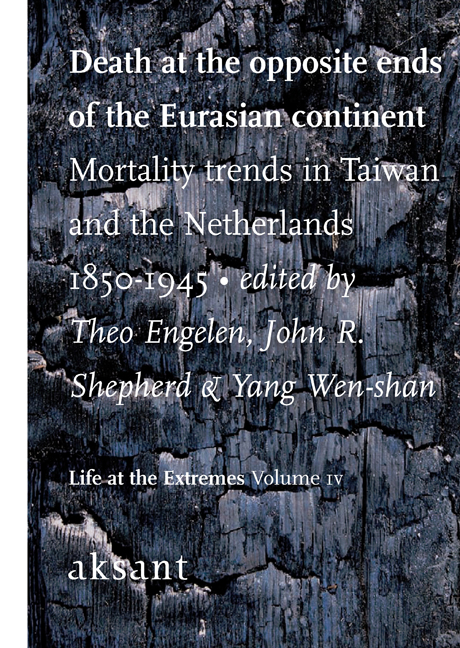 Death at the Opposite Ends of the Eurasian Continent
Death at the Opposite Ends of the Eurasian Continent Published online by Cambridge University Press: 22 January 2021
Maternal depletion refers to the possibility of ongoing decline in physical health during the reproductive life of a woman. It is the result of the growing metabolic burden of successive gestations and periods of lactation in societies where birth intervals are short. Especially when food is in short supply mothers will not be able to recover from a previous pregnancy before the next starts. Thus, depletion is a threat for all women experiencing short intervals between births. It is an even more serious threat for women growing older, since their recuperation takes longer (Wood 1994; Ellison 2001).This phenomenon has many implications for the women themselves and for their fecundity. In this paper we are interested in one specific implication: infants of depleted mothers run a higher risk of dying. Ellison specifically points out: “The shorter the interval separating births, the greater the risk of mortality of the offspring. Intervals of less than two years between births are particularly dangerous,” (Ellison 2001: 95-97).
Ellison's observation is not new. One of the well-known predictors for infant mortality is the length of the preceding birth interval. Studies of populations in different parts of the world and in different time periods have come to the general conclusion that inter-pregnancy intervals shorter than 18 months, in some cases shorter than 24 months, have a negative effect on the survival chances of children closing this interval (De Sweemer 1984; Conde-Agudelo 2006).
The causal link with infant mortality is through birth weight. Children born less than two years after the previous birth have a lower birth weight, their general condition is more likely to be frail, and, thus, their chances of reaching their first birthday relatively low (De Sweemer 1984: 50). All things being equal we expect this phenomenon to be visible in all societies. By definition, however, all things are not equal. Since we compare in this paper a Western European and a Chinese population we are dealing with societies that, for those who believe the observations by Thomas Malthus, regulated population growth via a preventive and a positive check, respectively. The preventive check used marriage restriction to limit the number of women marrying and to keep the age at marriage high.
To save this book to your Kindle, first ensure [email protected] is added to your Approved Personal Document E-mail List under your Personal Document Settings on the Manage Your Content and Devices page of your Amazon account. Then enter the ‘name’ part of your Kindle email address below. Find out more about saving to your Kindle.
Note you can select to save to either the @free.kindle.com or @kindle.com variations. ‘@free.kindle.com’ emails are free but can only be saved to your device when it is connected to wi-fi. ‘@kindle.com’ emails can be delivered even when you are not connected to wi-fi, but note that service fees apply.
Find out more about the Kindle Personal Document Service.
To save content items to your account, please confirm that you agree to abide by our usage policies. If this is the first time you use this feature, you will be asked to authorise Cambridge Core to connect with your account. Find out more about saving content to Dropbox.
To save content items to your account, please confirm that you agree to abide by our usage policies. If this is the first time you use this feature, you will be asked to authorise Cambridge Core to connect with your account. Find out more about saving content to Google Drive.